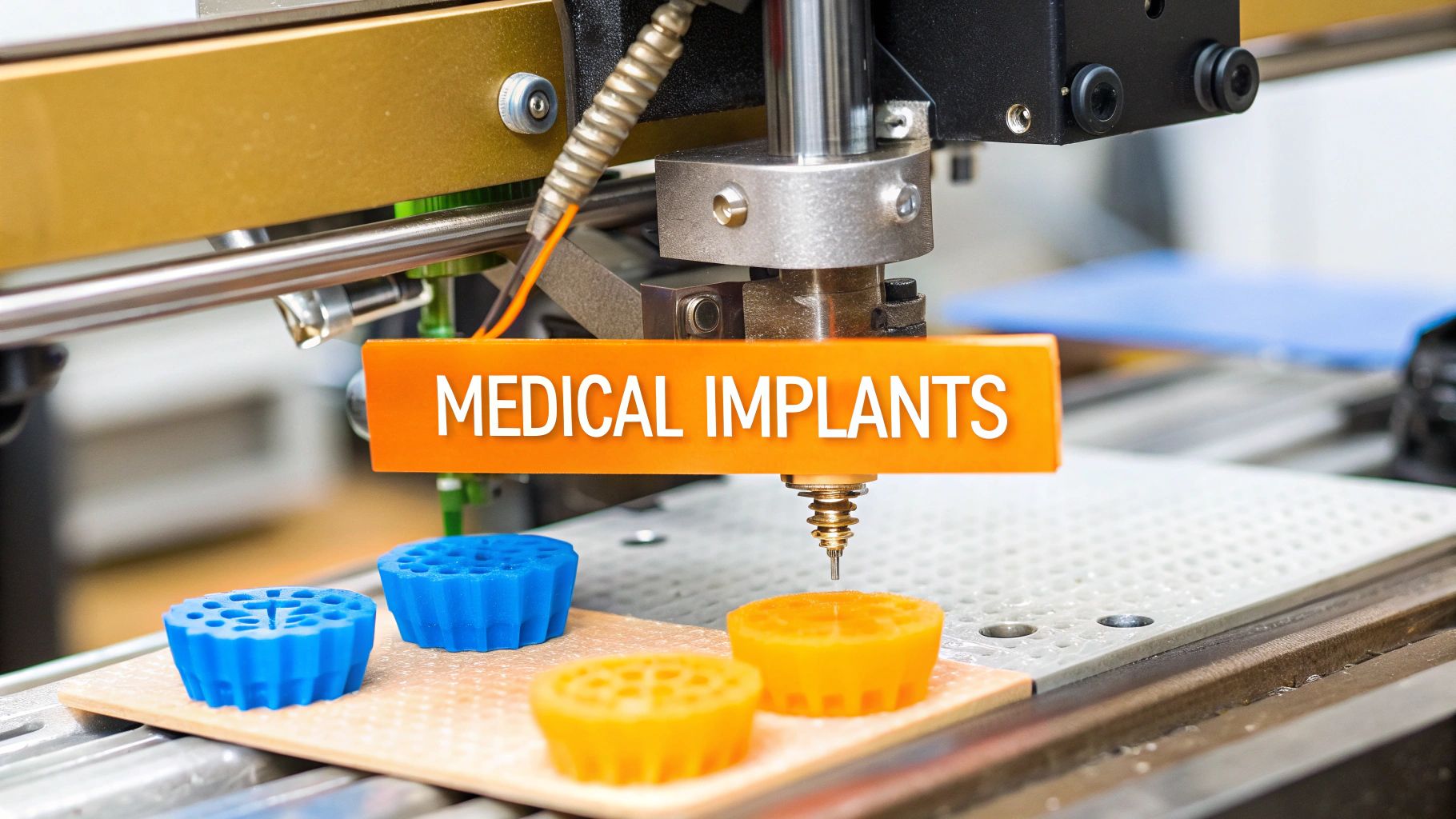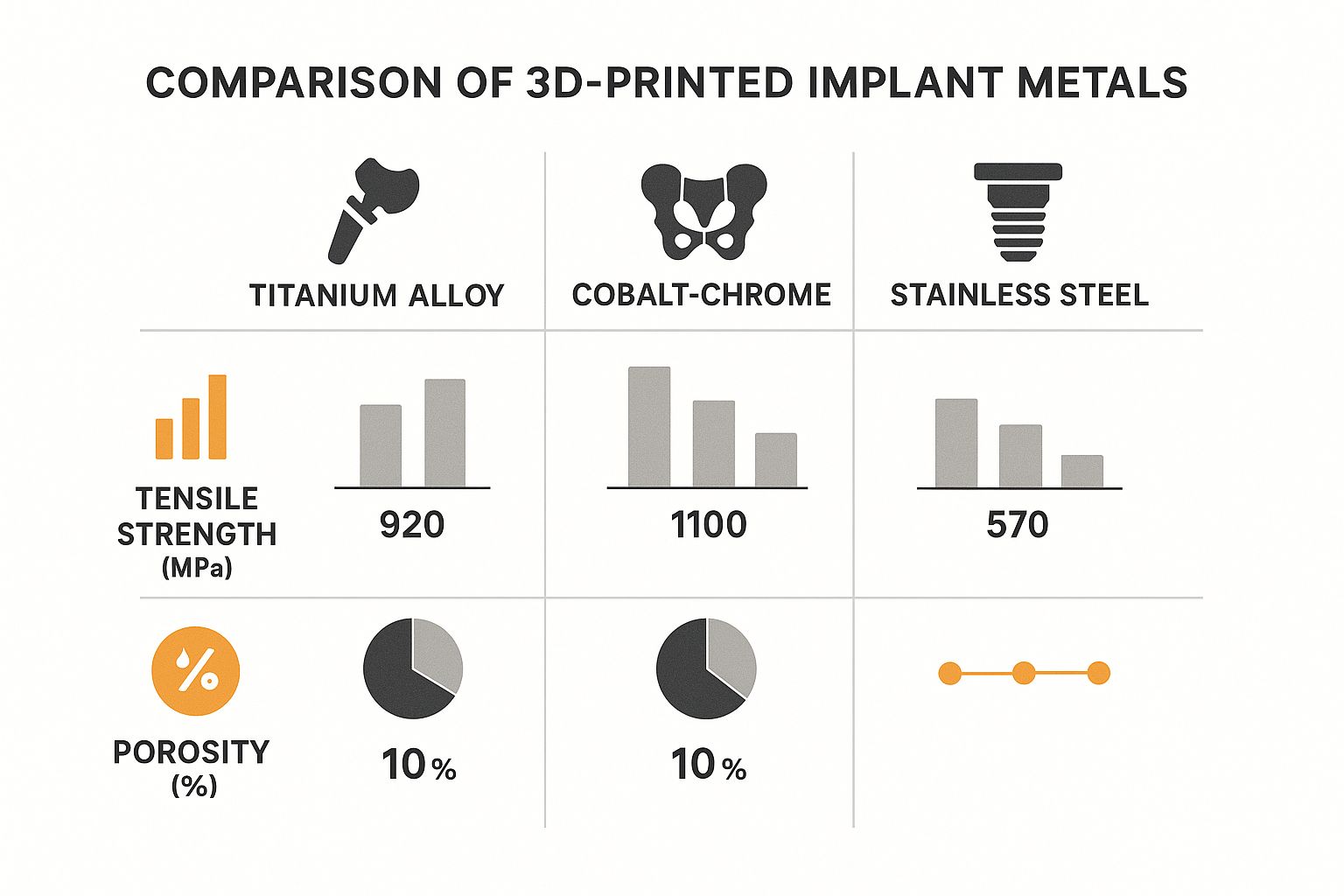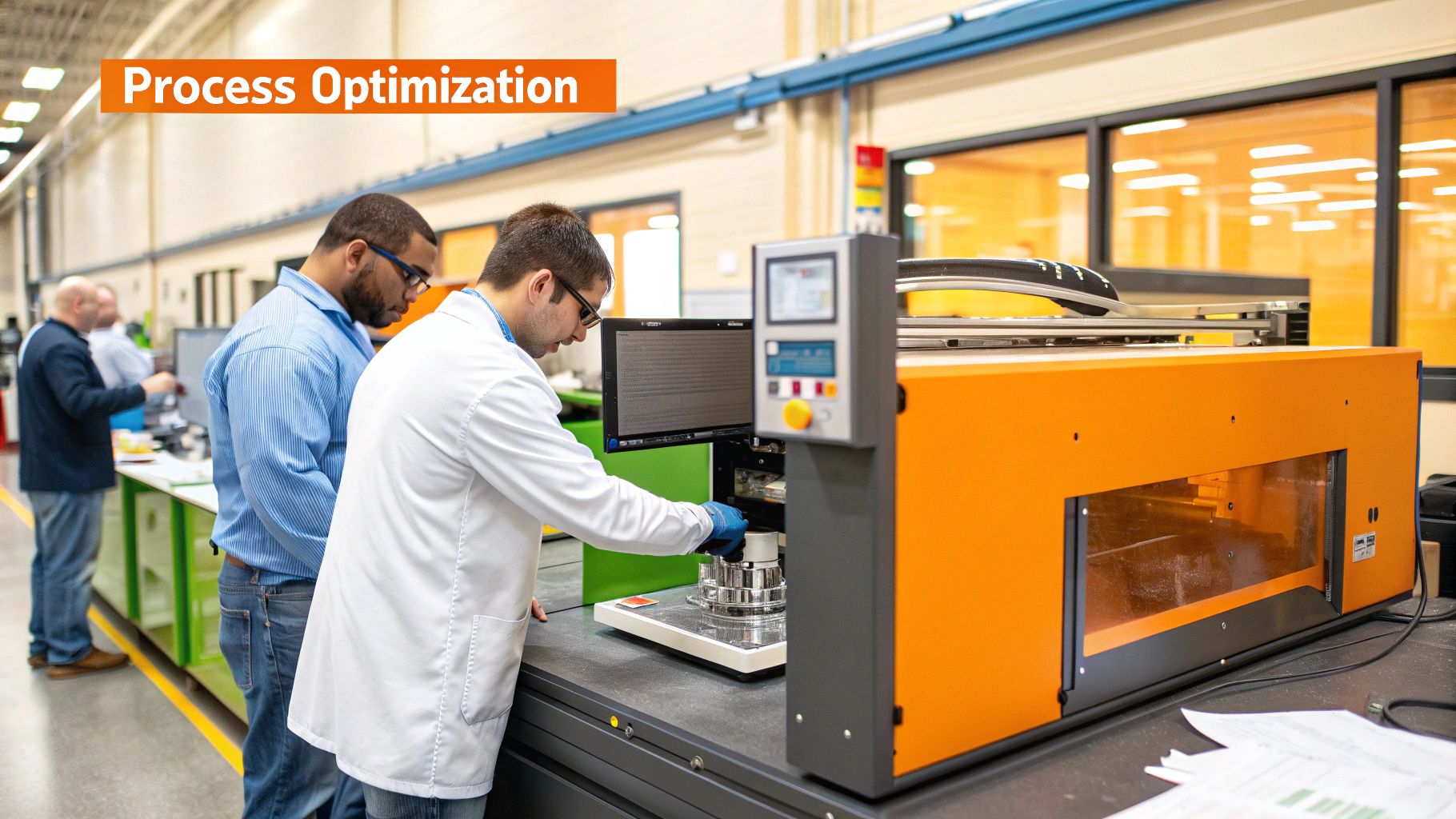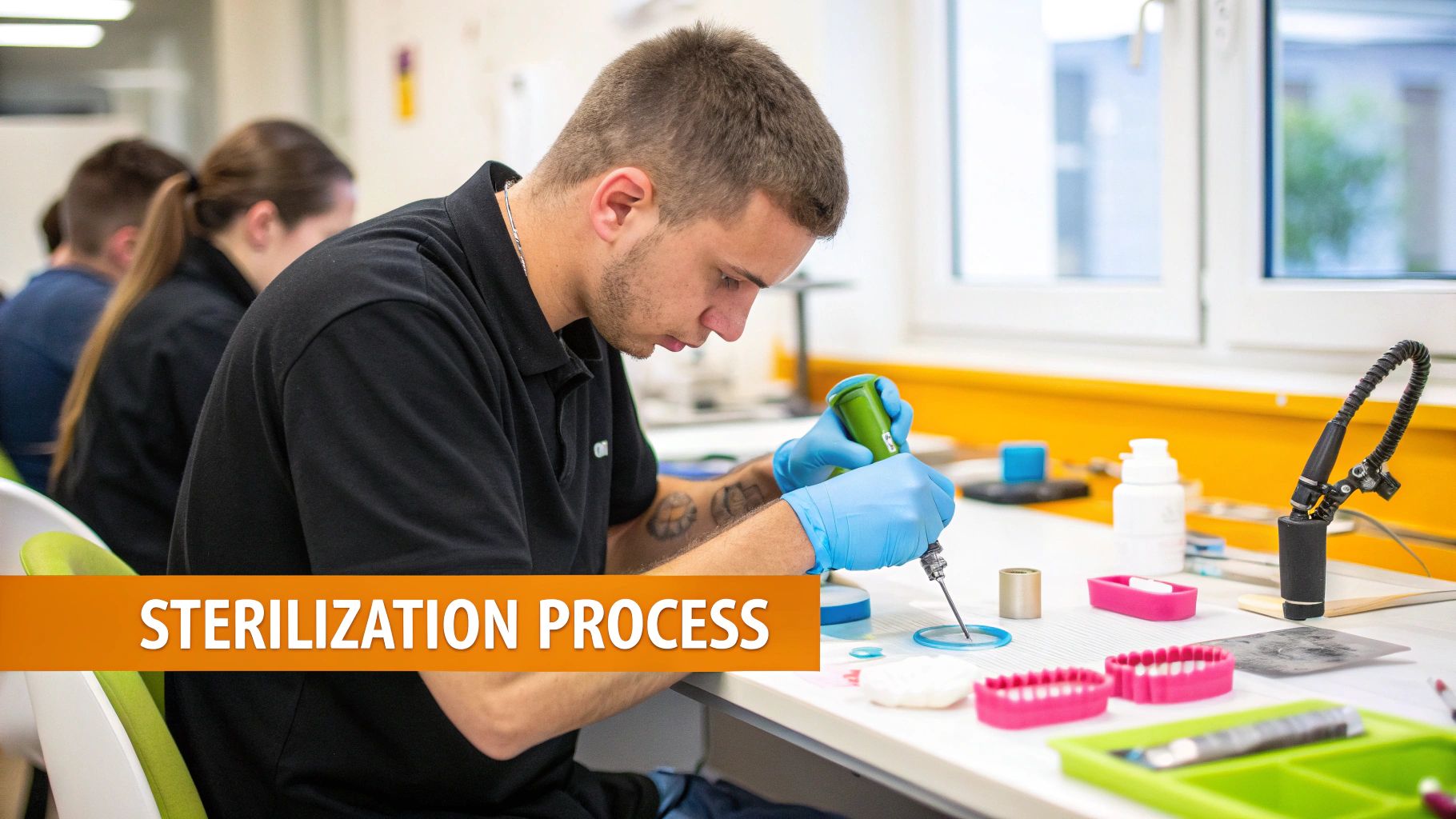The Revolution of Medical Implant 3D Metal Printing
Medical implants traditionally followed a "one-size-fits-most" approach due to limitations in manufacturing. This often meant compromising on fit and functionality, potentially impacting patient outcomes. However, 3D metal printing has changed the game for medical implants. This technology allows medical professionals to create patient-specific implants with incredible precision and complexity.
This personalized approach allows for better integration with the body, potentially leading to shorter recovery times and improved long-term success. This represents a major step forward in personalized medicine.
From Concept to Creation: Designing for the Individual
The process of creating a 3D-printed medical implant starts with detailed medical imaging, such as CT or MRI scans. This data is used to create a digital 3D model of the patient’s anatomy. This model allows surgeons and engineers to design an implant perfectly tailored to the individual's unique structure.
For example, a patient needing a cranial implant can have one designed to precisely match the contours of their skull. This improves both aesthetic and functional results. This personalized approach minimizes adjustments during surgery and promotes better integration with surrounding tissues. It truly highlights the shift from generalized solutions to individualized care.
Advantages Over Traditional Methods
Traditional implant manufacturing has limitations in design complexity and customization. 3D metal printing overcomes these limitations. It allows for the creation of complex shapes and porous structures impossible to achieve with conventional methods.
These advancements lead to better bone integration, a lower risk of implant rejection, and improved overall performance. Plus, 3D printing significantly speeds up production time. This means patients receive their custom implants faster. The growing market for 3D-printed medical implants reflects this trend. Projections show it reaching USD 4,348.4 billion in 2025, up from USD 3,716.6 billion in 2024. This growth underscores the increasing role of additive manufacturing in healthcare. Find more detailed statistics here: 3D Printing Medical Implant Market Report
A Collaborative Ecosystem Driving Innovation
Successfully implementing 3D metal printing for medical implants relies on collaboration between medical professionals, engineers, and technology specialists. This interdisciplinary approach ensures that implants are both technically sound and meet the patient’s specific clinical needs. This combined expertise encourages innovation and speeds up the development of new materials, designs, and applications for 3D-printed medical implants. This collaboration is key to pushing the boundaries of patient care.

Behind the Technology: How Medical Implant 3D Metal Printing Works
Medical implant 3D metal printing is changing patient care by creating customized implants designed for individual needs. But how does this process work? This section explores the steps involved in transforming a digital design into a real, life-changing medical device.
From Digital Blueprint to Physical Implant: The 3D Printing Process
The process starts with medical imaging, like CT or MRI scans, which provide detailed anatomical data. This data creates a precise 3D digital model of the area needing the implant. It's similar to a blueprint for a custom-built house, but instead, it’s a perfectly fitting medical implant. This digital model is the foundation for 3D printing.
This process uses additive manufacturing, adding materials layer by layer to build the final product. Several technologies are used in medical implant 3D metal printing:
- Selective Laser Melting (SLM): A high-powered laser melts and fuses metallic powder, layer by layer, following the digital design.
- Electron Beam Melting (EBM): Similar to SLM, EBM uses an electron beam as the energy source, allowing for high melting rates and processing reactive materials in a vacuum.
- Direct Metal Laser Sintering (DMLS): A laser sinters (heats and fuses) metallic powder without fully melting it, creating a somewhat porous structure.
Choosing the Right Tool for the Job: Technology Comparison
Each technology has strengths and weaknesses. SLM offers excellent precision and surface finish, making it suitable for intricate designs. EBM's vacuum environment and high melting rates are ideal for reactive materials like titanium alloys, common in medical implants. DMLS, with its porous structures, promotes bone integration for some orthopedic applications. Learn more in this article about laser technology advancements.
The data chart below visualizes a comparison of SLM, EBM, and DMLS across key metrics.

As shown in the chart, SLM excels in resolution, producing highly detailed implants, while EBM is faster, important for time-sensitive cases. DMLS, with lower resolution, offers greater material compatibility. Each technology meets specific medical implant fabrication needs.
To further clarify these differences, let's examine the following table:
Comparison of 3D Metal Printing Technologies for Medical Implants This table compares the primary 3D metal printing technologies used for medical implants, highlighting their strengths, limitations, and best applications.
| Technology | Resolution | Materials Compatibility | Surface Finish | Best Applications | Limitations |
|---|---|---|---|---|---|
| SLM | High | Moderate | Excellent | Intricate designs, small implants | Build speed, cost |
| EBM | Moderate | High (especially for reactive materials) | Good | Titanium implants, complex shapes | Resolution, cost |
| DMLS | Lower | High | Fair | Orthopedic implants promoting bone integration | Surface finish, mechanical properties |
This table summarizes the key differences between the three technologies, emphasizing their suitability for various medical implant applications.
Precision Engineering at a Microscopic Level
After printing, the implant undergoes post-processing: support removal, surface finishing, and sterilization. These ensure biocompatibility, eliminate defects, and prepare the implant for surgery. This precision is due to 3D printing's inherent control, allowing for complex geometries and porous surfaces that promote bone integration—features impossible with traditional manufacturing.
From Scan to Surgery: A Seamless Journey
The entire process, from patient scan to implant, shows the power of medical implant 3D metal printing. This technology allows personalized solutions for complex medical issues and often reduces lead times, improving patient outcomes. It’s a significant advancement in personalized medicine, offering hope and a better quality of life.
The Materials Making Medical Implant 3D Metal Printing Possible
Creating medical implants requires more than just picking any metal. These devices reside inside the human body, so they need specific properties for both safety and effectiveness. This means the materials used in medical implant 3D metal printing must be carefully chosen and optimized. Let's explore the specialized metals improving implant performance and patient outcomes.
Titanium Alloys: Strength and Biocompatibility
Titanium alloys are a cornerstone of medical implant 3D metal printing. Their exceptional biocompatibility minimizes the risk of the body rejecting the implant. Titanium's high strength-to-weight ratio makes it ideal for implants needing to withstand significant stress, like hip replacements. The porous structures created through 3D printing allow for bone ingrowth, further improving the implant's stability and lifespan.
Cobalt-Chromium Formulations: Durability and Wear Resistance
Cobalt-chromium formulations are another essential material group. These alloys excel in durability and wear resistance, making them well-suited for applications like dental implants and knee replacements. These implants experience constant friction and force. Cobalt-chromium's robust properties ensure they can withstand these challenges long-term. 3D printing allows for complex geometries, optimizing the implant's fit and function.
Advanced Stainless Steels: Versatility and Cost-Effectiveness
While titanium and cobalt-chromium are prevalent, advanced stainless steels also have a place in medical implant 3D metal printing. They offer a balance of versatility and cost-effectiveness. Certain stainless steel formulations are designed for 3D printing processes, offering good biocompatibility and mechanical properties. This makes them a practical choice for various applications, especially when cost is a factor. Medical imaging data needs to be converted to a 3D printable format. For example, you can Convert DICOM to STL Easily.
Emerging Composites and Alloys: Pushing the Boundaries
Beyond these established materials, research continually pushes boundaries. Composite materials, combining metals with substances like polymers or ceramics, are under development. This creates implants with enhanced functionality, like improved bone integration or drug delivery capabilities. Scientists are also creating new alloys specifically for additive manufacturing. These materials have the potential to surpass traditional options in strength, biocompatibility, and long-term performance.
The Balancing Act: Key Material Properties
All materials used in medical implant 3D metal printing must balance critical properties. Biocompatibility is essential, ensuring the implant doesn't cause adverse reactions. Resistance to bodily fluids is also crucial, preventing corrosion and breakdown over time. The implant needs adequate mechanical strength to handle stress. Finally, the material should encourage integration with natural bone for stability and long-term success. Ongoing research focuses on optimizing these properties for better patient outcomes. The 3D printing materials and services market, including metal additive manufacturing, was valued at USD 8.60 billion in 2024 and is projected to reach USD 16.82 billion by 2030. This growth is driven by investment in areas like bioprinting and metal additive manufacturing, particularly for medical implants because of the ability to create strong, lightweight structures. You can find more information here: 3D Printing Materials and Services Industry Report.
Custom-Crafted Care: The Power of Personalized Implants
Medical implant 3D metal printing is changing the doctor-patient relationship by enabling new levels of customization. Patients are no longer limited to standard implant sizes and shapes. Medical professionals can now create implants specifically designed for each individual's unique anatomy. This personalized approach is enhancing medical care.
The Journey to a Perfect Fit: From Imaging to Implantation
The process starts with advanced medical imaging, like CT and MRI scans, which capture the intricate details of a patient's anatomy. This data is then used to create a precise digital 3D model. It's like a blueprint, but for a perfectly fitting medical implant.
This digital model allows surgeons and engineers to collaborate on the implant design. This ensures it integrates seamlessly with the patient's body, achieving both a precise fit and optimal functionality. This level of personalized care isn't possible with traditional manufacturing methods.
Overcoming Anatomical Challenges: Tailored Solutions for Complex Cases
Personalized implants address anatomical challenges that were once difficult or impossible to treat. For instance, a patient with a complex bone fracture can receive an implant perfectly matched to the fractured area, promoting faster and more effective healing. This ability to create custom solutions is a major advancement for patients with unique needs.
This targeted approach reduces the need for extensive adjustments during surgery. This minimizes the risk of complications and improves patient outcomes. It also allows surgeons to confidently attempt procedures they might have considered too risky with standard implants.
Transforming Lives: Patient Testimonials and Surgical Successes
The impact of personalized implants extends beyond improved surgical outcomes. It truly transforms lives. Patients who once faced limited mobility or chronic pain can regain function and enjoy a higher quality of life thanks to implants designed specifically for them. This personalized approach offers new hope for patients with rare conditions or complex anatomical variations.
Surgical teams also benefit from this technology. They see improved operating efficiency, reduced complication rates, and faster healing times in their patients. The precision of these custom-designed implants streamlines surgical procedures and increases predictability, leading to better patient experiences. Read also: How to master laser technology.
A Collaborative Future: Advancing Personalized Care
Medical implant 3D metal printing continues to advance, driven by the collaboration of medical professionals, engineers, and manufacturing specialists. This partnership fosters innovation and expands the possibilities of patient care. The potential applications of this technology are growing, offering promise for a healthier future.
The broader trend towards personalized healthcare solutions is evident in areas like 3D-printed plastics. The global medical 3D printing plastics market was valued at approximately USD 682.04 million in 2024. Projections indicate it will reach USD 6,454.36 million by 2034, growing at a CAGR of 25.20%. Learn more about the growth of this market here. Medical implant 3D metal printing exemplifies the powerful impact of personalized medicine.

Real Patients, Real Results: Success Stories That Inspire
Medical implant 3D metal printing is changing how we approach healthcare. It's not just a technological leap; it's a pathway to improving lives. This section delves into the real-world impact through inspiring success stories, showcasing how 3D-printed implants tackle complex medical issues and enhance patient outcomes across various specialties.
Orthopedics: Restoring Mobility and Reducing Pain
3D-printed metal implants are becoming increasingly common in orthopedics for joint replacements and fracture repairs. Consider a patient with a severely fractured tibia. A custom-designed, 3D-printed implant offers a precise fit to the damaged area. This personalized approach encourages faster healing and better bone integration than traditional methods. The implants can also be designed with porous structures to promote bone ingrowth, further enhancing stability and long-term success.
- Example: A patient with a complex pelvic fracture, unsuitable for standard implants, received a 3D-printed titanium implant. The implant was designed to match their unique anatomy. This innovative solution enabled successful reconstruction and restored their mobility.
Dental Reconstruction: Achieving a Perfect Smile
3D metal printing is revolutionizing dental reconstruction. Custom-made dental implants, fabricated from biocompatible materials like titanium, provide a perfect fit and superior aesthetics.
- Example: A patient requiring multiple dental implants received a 3D-printed solution perfectly matched to their jawbone structure. This precise design ensured optimal implant placement, resulting in a stable and natural-looking smile.
Cardiovascular Interventions: Repairing Hearts and Saving Lives
Even complex cardiovascular procedures are benefiting from 3D metal printing. Surgeons can use this technology to create patient-specific heart models for intricate surgical planning or to design custom stents and valves.
- Example: A young patient born with a complex heart defect received a life-changing 3D-printed implant. The implant repaired the defect and significantly improved their heart function and quality of life, demonstrating the immense potential of this technology.
Facial Reconstruction: Restoring Form and Function
3D-printed implants provide new hope for patients facing facial reconstruction after trauma or due to congenital conditions. The exceptional precision of these implants allows for the accurate recreation of complex facial structures, restoring both form and function.
- Example: Following an accident, a patient requiring jaw reconstruction received a 3D-printed titanium implant precisely contoured to their face. This restored their ability to speak and eat normally, dramatically improving their overall well-being.
To better illustrate the breadth of applications, the table below summarizes key uses of 3D printed metal implants across different specialties:
Medical Implant 3D Metal Printing Applications by Specialty
This table presents key applications of 3D printed metal implants across different medical specialties, showing typical implant types, materials used, and patient benefits.
| Medical Specialty | Common Implant Types | Preferred Materials | Key Patient Benefits | Typical Recovery Improvement |
|---|---|---|---|---|
| Orthopedics | Joint replacements, fracture fixation devices | Titanium alloys, cobalt-chromium alloys | Improved fit, faster healing, better bone integration | Reduced pain, increased mobility, faster return to activity |
| Dental Reconstruction | Dental implants, crowns, bridges | Titanium, zirconia | Enhanced aesthetics, improved stability, customized fit | Improved chewing function, enhanced smile, greater confidence |
| Cardiovascular | Stents, valves, heart models | Titanium alloys, nickel-titanium (Nitinol) alloys | Precise placement, improved blood flow, personalized treatment | Reduced risk of complications, improved cardiac function, better quality of life |
| Facial Reconstruction | Craniofacial implants, jaw reconstructions | Titanium, biocompatible polymers | Restoration of form and function, improved quality of life | Improved speech, chewing, and facial aesthetics, increased self-esteem |
This table highlights the versatility of 3D metal printing in creating implants tailored to specific patient needs. Faster healing, improved function, and enhanced aesthetics are just some of the key benefits observed across these medical specialties.
Democratizing Access to Advanced Treatments
3D-printed implants offer unique solutions for patients with rare conditions or complex anatomical challenges not addressed by standard implants. This personalized approach expands access to advanced treatments, offering hope and improved outcomes. As this technology continues to evolve, we can anticipate even more innovative applications and further improvements in patient care.
Navigating Safety: Regulation in the 3D Printing Revolution
Medical implant 3D metal printing holds immense promise for personalized healthcare. However, ensuring the safety of these devices is absolutely critical. This section explores the regulations surrounding this technology, focusing on the testing and quality control measures involved.

Rigorous Testing and Validation: Ensuring Implant Safety
Before a 3D-printed medical implant reaches a patient, it undergoes a battery of tests. These tests evaluate biocompatibility, ensuring the implant won't cause adverse reactions in the body. Mechanical properties like strength and durability are also assessed. The implant must withstand the stresses it will encounter during its intended use. Finally, resistance to corrosion and wear from bodily fluids is crucial for long-term safety and effectiveness.
Adapting Regulatory Frameworks: The FDA and International Standards
Regulatory bodies like the FDA (Food and Drug Administration) and various international organizations are updating their frameworks to address the unique challenges posed by 3D-printed implants. Traditional regulations were created for mass-produced devices. The inherent variability in custom, 3D-printed implants requires more specialized validation processes. This ensures consistent quality despite the unique nature of each implant. You might also find this interesting: How to master laser technology.
Quality Assurance: Building Safety into the Process
Industry leaders are proactively integrating quality assurance into every step of the design and production process. This minimizes potential risks and promotes consistent implant quality. Key aspects of this approach include:
- Validating additive manufacturing processes: Ensuring the reliability and repeatability of the 3D printing process.
- Tracing materials and production parameters: Maintaining detailed records allows for traceability and quick action if any issues arise.
- Implementing rigorous quality control checks: Regular inspections at each production stage help identify and address defects.
Collaboration and Standardization: A Path to Safe Innovation
Collaboration between manufacturers and regulatory bodies is essential for developing appropriate standards. This partnership seeks to balance patient safety with continued innovation. Regulations must be strong enough to guarantee safety but flexible enough to allow for advancements in medical implant 3D metal printing.
Addressing the Challenges of Customized Production
One of the major challenges is the inherent variability in customized production. Unlike mass-produced implants, each 3D-printed device is one-of-a-kind. This necessitates robust quality control measures to ensure consistency and reliability.
The Importance of Traceability and Documentation
Maintaining comprehensive records is paramount. Every stage of the process, from initial design to final sterilization, must be documented. This traceability allows manufacturers to quickly pinpoint the source of any problems. It also enables regulatory bodies to monitor compliance, further ensuring patient safety.
Looking Ahead: The Future of Regulation
As 3D printing technology progresses, regulations must keep pace. Continued dialogue between industry stakeholders and regulators is key to maintaining the balance between innovation and patient safety. The future of medical implant 3D metal printing hinges on a regulatory framework that is both rigorous and adaptable, protecting patients while supporting the development of life-changing devices.
The Future of Medical Implant 3D Metal Printing
Medical implant 3D metal printing is already changing how we approach patient care. The future holds even more potential for improving patient lives. Let's explore some exciting innovations on the horizon.
Multi-Material Printing: Expanding Possibilities
One promising area is multi-material printing. This technique combines metals with other biocompatible materials, like polymers or ceramics.
Imagine an implant with a strong metal core and a porous polymer coating to encourage tissue integration. This combination of materials enhances functionality and expands the range of applications.
Artificial Intelligence: Personalized and Predictive
Artificial intelligence (AI) is becoming increasingly important. AI algorithms can analyze patient-specific data, such as anatomical scans, to create perfectly customized implants. This leads to improved fit, function, and long-term performance.
AI can also predict the lifespan of an implant, informing decisions about material selection and design. This helps identify potential issues early on, leading to safer and more effective solutions.
Bioactive Implants: Integrating Device and Therapy
Bioactive implants represent another leap forward. These implants can release therapeutic agents, like drugs or growth factors, directly into the body. Think of an implant replacing damaged bone while simultaneously releasing growth factors to accelerate healing.
This fusion of device and therapy opens exciting new treatment possibilities. Bioactive implants have the potential to revolutionize care for complex conditions.
Shape-Changing Implants: Adapting to the Body
Researchers are exploring 4D printing, which creates implants that change shape over time in response to stimuli like body temperature. These “shape-changing” implants are incredibly promising for situations where adaptation to changing anatomical conditions is crucial.
For example, a stent could expand as a blood vessel grows, ensuring continued effectiveness. While still early in development, 4D printing represents a bold step forward.
Innovations Transforming Clinical Practice
While much innovation is still underway, several advancements are nearing clinical application:
- Personalized cranial implants: These implants precisely match skull contours for improved aesthetics and function.
- Patient-specific joint replacements: Custom-designed implants lead to better fit, faster recovery, and improved mobility.
- Bioactive dental implants: Drug delivery systems within the implants can fight infection or promote bone growth.
These advances will improve patient outcomes and personalize treatment options. The continued evolution of these technologies promises to reshape healthcare.
For more on laser technology and its various applications, including medical advancements, check out Laser Insights China. Stay up-to-date on the latest breakthroughs and connect with a passionate community.

